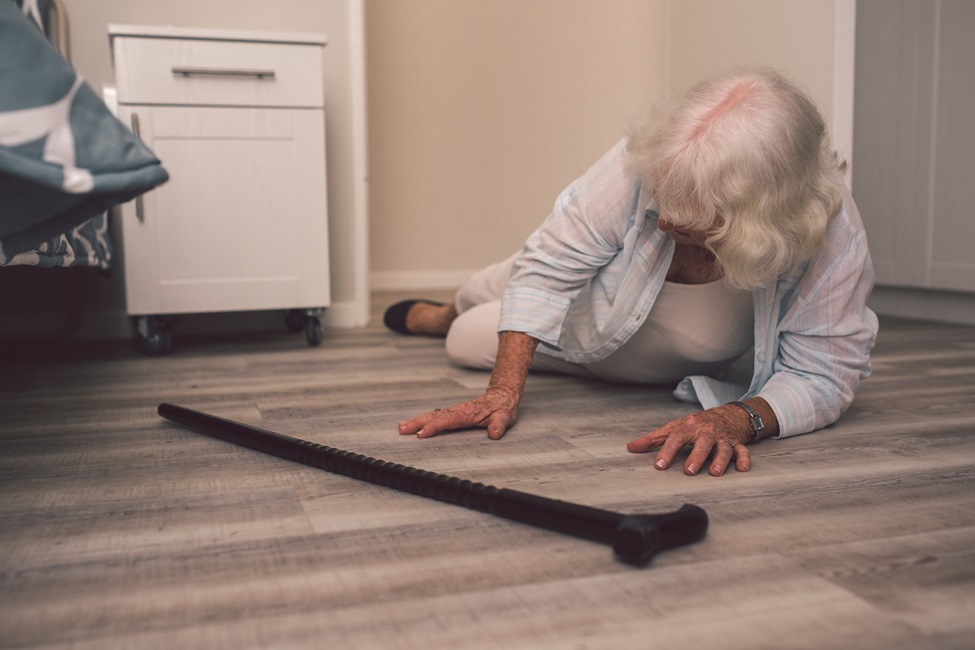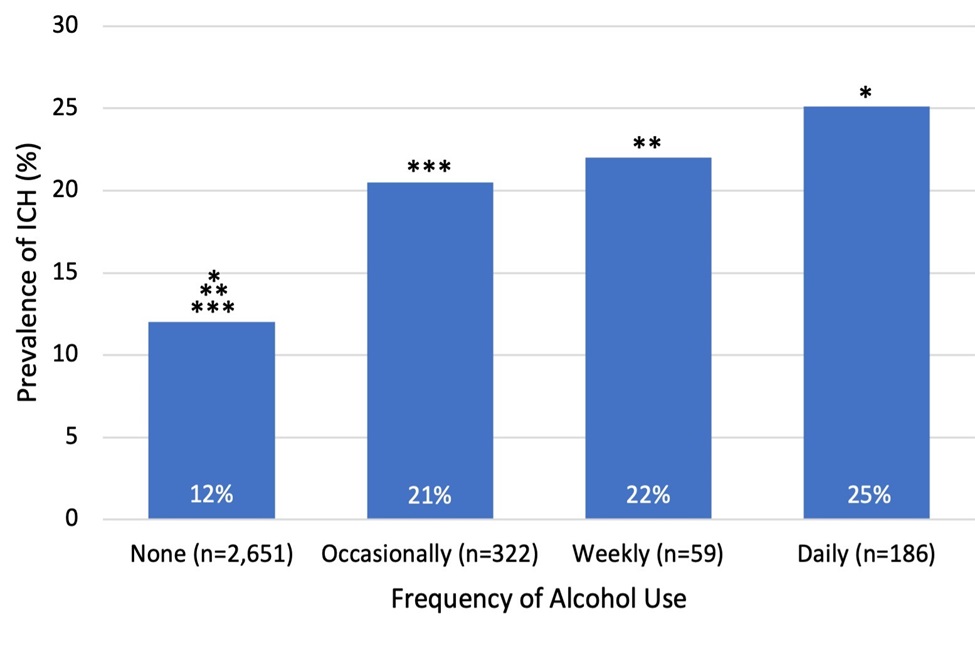Alcohol Use in Older Adults Doubles Risk of Brain Bleeds from Falls

Daily alcohol use was associated with 150% increased odds of a brain bleed in older adults after a head trauma from a fall.
Nationally, falls remain the leading cause of both fatal and non-fatal injuries in older adults and are the leading cause of traumatic brain injury. In 2021, falls led to the deaths of 36,500 older adults in the United States and 3,805 older Floridians. While some studies have hypothesized that alcohol use contributed to these outcomes, there are few studies which have examined this issue.
As such, little is known about the association between the frequency of alcohol use and the severity of injuries sustained after a fall in older adults. A study by Florida Atlantic University’s Schmidt College of Medicine and collaborators, is one of the first to examine the relationship between self-reported alcohol use and severe head trauma in this group.
For the study, researchers used data from the Geriatric Head Trauma Short Term Outcomes Project (GREAT STOP), which included a prospective cohort of consecutive patients presenting to the emergency departments (ED) of two level one, university-affiliated trauma centers in Palm Beach County, with annual volumes of 50,000 and 69,000.
Patients aged 65 and older who sustained blunt head trauma following a fall were included in the study. Trained research assistants screened all older ED patients to enroll those with head trauma. Data collected included age, race, sex, smoking, alcohol use, drug use, antiplatelet use, anticoagulant use, mechanism of injury, past medical history, and loss of consciousness.
All patients were asked about alcohol use and were asked to categorize their use as none, occasional, weekly, or daily. Intracranial hemorrhage (ICH), a head trauma that takes place in various areas of the brain, was determined from the patient’s head CT scan as read by the attending hospital radiologist.
The study, published in the Journal of the American College of Emergency Physicians Open, involved 3,128 participants who underwent an initial head CT after head trauma from a fall. Of these, 433 (13.5%) were diagnosed with ICH. Notably, 561 (18.2%) of older adults in the ED with head trauma reported drinking alcohol, with 6% indicating daily consumption.
“We observed that occasional alcohol use was associated with double the odds of intracranial hemorrhage when compared to patients with no alcohol use. Daily alcohol use was associated with 150% increased odds of intracranial hemorrhage,” said Richard Shih, M.D., corresponding author and a professor of emergency medicine, FAU Schmidt College of Medicine. “One of the unexpected findings in our study was the strong dose‒response relationship between reported alcohol use and intracranial hemorrhage.”
Weekly and daily alcohol users tended to be younger, with a mean age of 78 years, while non-alcohol users tended to be older, with a mean age of 83 years. ICH was more significantly common in alcohol users than in nonusers (22% vs. 12%). Strikingly, the prevalence of ICH increased with increasing frequency of alcohol use. While the risk of ICH was already high for non-alcohol users, the absolute risk of differences for ICH associated with alcohol use were substantial, rising from a risk increase of 8.5% in occasional alcohol users to an increase of 13.1% in daily alcohol users.
Many risk factors for falling have been identified in older adults such as polypharmacy, a sudden drop in blood pressure, and home environmental dangers. Findings from this study warrant the consideration that alcohol use should be regarded as another important, independent, modifiable risk factor for falling.
“Drinking alcohol can make you more likely to fall because it affects your balance, concentration and awareness,” said Shih. “It’s also worth noting that as individuals age, the effects of alcohol are increased. This is because older adults often have a higher percentage of body fat to body water ratio, thus increasing the concentration of alcohol in the bloodstream. Furthermore, alcohol metabolism decreases with age, exacerbating this effect, because older adults don’t process alcohol as efficiently as they used to.”
Current fall prevention guidelines, such as the Centers for Disease Control and Prevention’s Stopping Elderly Accidents, Deaths & Injuries (STEADI) initiative or the American Geriatrics Society Clinical Practice Guidelines for Prevention of Falls in Older Adults, do not address the relationship between alcohol use and falls.
“Our findings suggest that alcohol use assessment and mitigation strategies may be useful additions to fall prevention strategies,” said Shih.
Study co-authors are Alexander Zirulnik, M.D., first author and an emergency medicine resident at Harvard Medical School and Mass General Brigham; Shan Liu, M.D., an associate professor of emergency medicine at Harvard Medical School; Mike Wells, Ph.D., a research assistant professor, FAU Department of Emergency Medicine; Scott Alter, M.D., an associate professor of emergency medicine and assistant dean for clinical research, FAU Schmidt College of Medicine; Gabriella Engstrom, Ph.D., senior project coordinator, FAU Schmidt College of Medicine; Joshua Solano, M.D., an associate professor of emergency medicine, FAU Schmidt College of Medicine; Lisa M. Clayton, D.O., chair and associate professor, FAU Department of Emergency Medicine, program director, emergency medicine residency, and assistant dean, graduate medical education; Mark Reiter, M.D., University of Tennessee Health Science Center; Patrick G. Hughes, D.O.; and Lara Goldstein, Ph.D., Department of Emergency Medicine, Memorial Healthcare System.
The study was financially supported by the Florida Medical Malpractice Joint Underwriting Association Grant for Safety of Health Care Services (grant RFA #2018-01) and GREAT STOP awarded to Shih, principal investigator.

-FAU-
Latest News Desk
- Hope for Brain Cancer: FAU Awarded Grants for Glioblastoma TreatmentFAU researchers are pioneering a new approach to treating glioblastoma - a highly aggressive brain cancer with one of the highest mortality rates - by targeting the gene MBLAC1 for the first time.
- John Kelly, Ph.D., Announces Retirement from FAUAfter over a decade of dedicated service, John Kelly, Ph.D., announced his retirement from FAU. Having served as FAU's president during a transformational eight-year tenure, his last day will be June 30.
- Chef José Andrés' Longer Tables Fund Will Expand FAU Queen Conch LabThe grant awarded to FAU Harbor Branch supports the expansion of its queen conch aquaculture lab and is part of a global philanthropic effort to tackle urgent challenges through the power of food.
- FAU Gets $1M to Prevent Medication-related Harm, Falls in Older AdultsFAU Schmidt College of Medicine researchers will develop a targeted approach to eliminate the guesswork in medication management to reduce the risk of adverse drug events - particularly dangerous falls.
- FAU Grad Students Win Global Supply Chain Case CompetitionA team of three graduate students from Florida Atlantic University's College of Business won the second annual Supply Chain Case Competition for their theoretical applications to a current business problem
- Suicide Risk Elevated Among Young Adults with DisabilitiesSuicide is the third leading cause of death in young adults. For those with intellectual and developmental disabilities, the crisis is worse. New research urges prevention, screening and intervention reforms.






